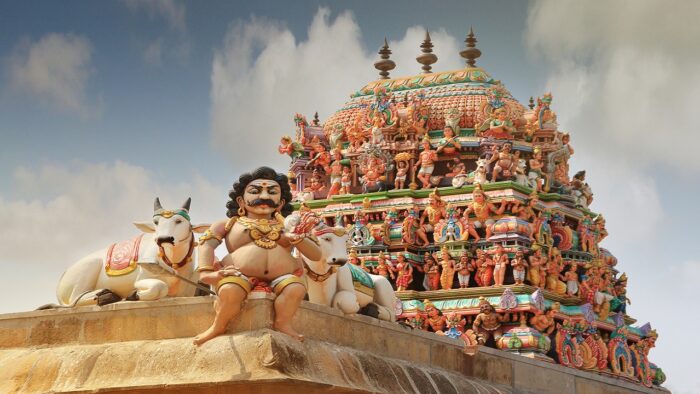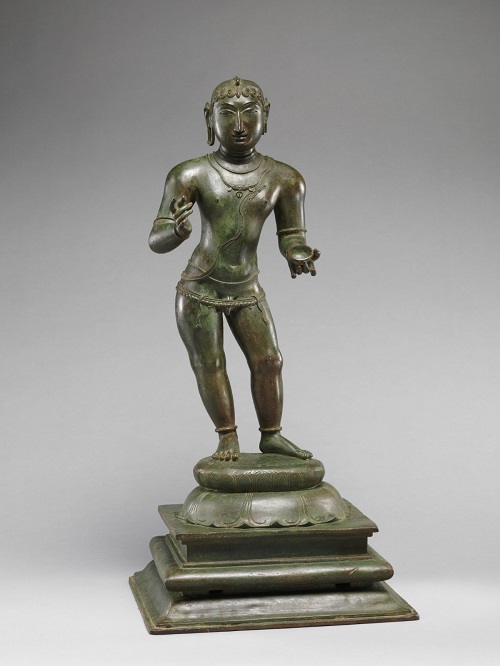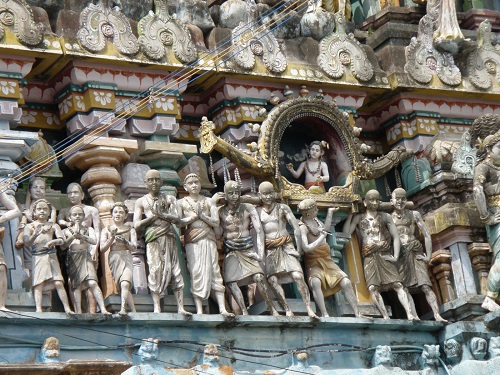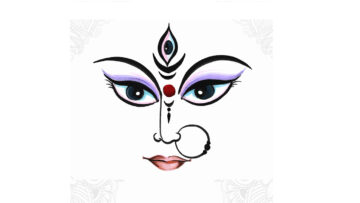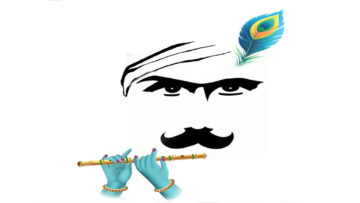Abstract
Thiru-Jñāna-Sambandhar is hailed as the first of the four most venerated Acharyas of the Tamil Saiva tradition. His advent in 6th-7th century CE happened at a time when sizeable parts of the Tamil country were near-totally in the grip of Jainism. This was the main cause for social constriction and stagnation, as evidenced by deterioration of Vedic culture, native language, literature and music, decline in the status of women. The focus of this paper is to study how Sambandhar’s mission was to extricate and liberate the then Tamil society from this through Vaidika Saiva renaissance.
In the Jaina theological worldview, Vedic Yajña was despised, music branded as a baser and non-spiritual sensual pleasure, Prakrita promoted over both Sanskrit and Tamil languages, women considered unfit for Moksha in the current birth. Sambandhar’s counter to this involved the expression and propagation of Vaidika Saiva theology in multifarious ways. He connected music with worship and gave a new lease of life to the dying Tamil music through his compositions that are sung in the Tamil Ragas till date. He associated with and gave a place of honour to Thiru-Nīlakanta-Yāzh-Pāṇar of the musical bard community that had become an inferior caste, fallen from its earlier high status. His acts of empathy for women were towards restoring the honourable place for them. His identification with Tamil and Veda in the signature verses of his hymns was with a specific purpose.
Sambandhar names Jainas and Bauddhas and harshly attacks them in his verses, much in the line of what can be seen in the polemical literatures of many religious sects in ancient and medieval India. Saiva lore narrates a major incident of direct conflict between him and the large assembly of Jain monks in Madurai, in which Jains attempt to harm him physically and fail and then challenge for a debate in which they lose. Then they are killed by impalement by the order of the Pandya king as per the terms of the bait. The impalement story does not have any other corroborative evidence, specifically in the Jaina records. Jaina temples and monks thrived in Tamil Nadu for several centuries after this era, patronized by almost all the kings. Though this story repeatedly finds a place in later Saiva texts and art, it does not have any historical basis. So, this episode is certainly not an example of religious persecution in ancient India.
Introduction
(Figure 1: Credit: Metmueseum – Thiru Jnana Sambandhar)
Thiru Jnana Sambandhar is hailed as the foremost of the four major Saiva Acharyas of the Tamil country. His glorious advent is described with great euphoric spirit in the below verse by the poet Sekkilar, the chronicler of the lives of the sixty-three Nayanmars in his Kavya dated to 12th century CE (Sekkilar: verse 1).
For the ways of the Vedas to flourish
For Saivism to shine in splendour
And for the excellence of the human race
He opened his holy and flowery lips and cried.
In yet another place, Sambandhar is mentioned as “the great Vedic gem who was born to eradicate the darkness that engulfed this land” (Sekkilar: verse 190). Such praises are not very uncommon in the hagiographic works that were written to glorify kings and saints. But in this specific case, these also contain an important historical narrative. The “darkness” that is spoken of here is the influence of non-Vedic Jaina and Bauddha religious sects, especially the former, leading to the overall spiritual, cultural and social decay from the Saiva perspective. The traditional Purana style account Sambandhar’s life as filled with many mystical events right from the very start when he becomes an instant hymnist at the age of three, getting the divine vision of Shiva-Parvati while crying for milk, with the purest heart of a child. Heralding a great Vaidika Saiva renaissance in the Tamil country touring many shrines and performing miracles, he merges with Shiva at the tender age of sixteen. Setting aside the supernatural elements in the story, the historicity of the persona of Sambandhar is beyond question and so is the lasting impact of his hymns and mission. By properly decoding and interpreting the life incidents and miracles, the import of his mission can be understood in full, and this will be the approach followed in this paper.
The major religious conflict in that age was between the non-Vedic Jaina and Bauddha religious traditions on the one side and the Vedic religious traditions on the other side that included philosophical schools like Samkhya and Vedanta, and religious sects like Shaivism and Vaishnavism. The Vedic schools often fought with the non-Vedic schools individually as sects as well as collectively with the combined strength of the whole tradition. This whole encounter remained in the form of intellectual debates and the religious preaching by all the groups was conducted in a peaceful manner. This is because the Indic kings of the pre-Islamic era assured protection and freedom to all the diverse religious traditions in their kingdom, as a general case. There were also exceptions in which the royalty attempted to impose its religious choices among the common citizens of the land which often resulted in friction and bitterness. But, overall, there is no evidence for any kind of religious war or religious persecution of a substantial scale in the pre-Islamic India under the rule of Indic kings and monarchs in any part of India. The real historical evidence contrasts with the unsubstantiated narratives by the Marxist oriented historians like Romilla Thapar who attempt to portray an India rife with inter-sectarian religious wars involving various Hindu, Jaina, Bauddha religious sects (Elst 1993: p. 74-85). This is done with the motive of whitewashing and “normalizing” the brutal record of Abrahamic religions of Islam and Christianity in India in their aggression to eradicate India’s indigenous religious traditions.
The focus of this paper is to study how Sambandhar’s mission contributed to the enrichment of Tamil society through Vaidika Saiva renaissance and to understand his conflict with the Jainas in the above-mentioned context.
Tamil country in the 7th century CE during the advent of Sambandhar
In the history of the Tamil country, the period 200 BCE to 300 CE is marked as the Sangam Age. This is the period in which various regions of the land were ruled by multiple kings and chieftains, major among them being the Chera, Chola and Pandya and the Vedic-Puranic Hindu culture was predominant. The Sangam classical literature of this period is filled with rich references to Vedas, Vedic sacrifices, Brahmanas, deities like Shiva, Vishnu, Indra, Kartikeya and Durga and stories from Itihasa and Puranas. Then followed the period which is classically called by the name “Kalabhra interregnum”.
“The joyous faith in good living that animates the poems of Sangam age gradually gives place to the pessimistic outlook on life that is, in the last resort, traceable to the emphasis laid by Buddhism [and Jainism] on the sorrows of life… A long historical night ensues after the close of the Sangam Age. We know little of the period of more than three centuries that followed. When the curtain rises again towards the close of the sixth century AD, we find that a mysterious and ubiquitous enemy of civilization, the evil rulers called Kalabhras (Kalappalar), have come to upset the established political order which was restored only by their defeat at the hands of the Pandyas and Pallavas as well as the Chalukyas of Badami… This dark period marked by the ascendency of Buddhism, and probably also of Jainism was characterized also by great literary activity in Tamil” (Sastri 1955: p. 58).
These are the words of the renowned historian KA Nilakanta Sastri. The origin of the Kalabhra rulers has been variously proposed as outside of the classical Tamil country that has Venkatam (present day Tirupati) and Kanyakumari as its boundaries, as Shravanabelgola region of Mysore or the Amaravati region of Andhra. This above-mentioned generalization gave way to more nuanced understanding of the Kalabhara rulers in later books. So, Kalabhra rulers were not total “evil” as characterized by the early modern historians. They were largely followers and patrons of Jainism and Buddhism at least during the initial periods of their entry and reign, and then also of Vedic religions of Saivism and Vaishnavism later (Kasinathan 1981). But the dominant Buddhist-Jaina influences that were established in the Tamil country lasted even after the Kalabhra rulers were overthrown. Especially the southernmost region of the Pandya Naadu with its capital in Madurai, which had been the traditional seat of Tamil Sangam and Vedic culture was firmly in the grip of Jainism. The Tamil Sangam was replaced by the Jaina Sangha under the leadership of Vajranandi Acharya. Periya Puranam describes the condition like this:
“All the temples in the Tamil Nadu of Pandyas had been converted into Jain monasteries and Jain temples. There were only Jains everywhere, like groups of darkness carrying their peacock feather fans; wherever one turned there were only hair-plucked heads, mat dress and peacock feather fans and the triple parasols of the Jains. People had been lured into following their books and no one would turn their minds to the Saiva path” (Sekkilar: verse 601,602).
Such were the conditions during the advent of Sambandhar. The date of the first half of the 7th century CE (600- 650 CE) for Sambandhar has been accepted by all historians, as his contemporary Pandya king is identified as Maravarman Avani-Sulamani or his grandson Arikesari Maravarman (Sastri 1955: p. 272).
Jaina influence leading to social stagnation,Vaidika Saivism as counter theology
The Indian academic historians of the Marxist school have created a general picture of the “rebel” non-Vedic religions of Jainism and Buddhism being more egalitarian, people-friendly and “progressive” as opposed to the Varnashrama oriented, rigid, and “Brahmanical” Vedic and Puranic Hindu religious traditions that were “regressive”. This prejudicial and one-sided narrative simply does not have historical basis. Regarding the history of Tamil Nadu, the subjective opinion of all major historians before the era of total academic domination of Marxist historians starting 1970s has been the opposite. The subjective opinion also got bolstered by multifarious analysis of Tamil literary sources, epigraphs and other historical evidence. The book by M. Arunachalam gives a detailed picture of the social decadence that had set due to Jaina influences. The summary of these findings from the book are given in the following subsections (Arunachalam1979: p.65-105). The narrative about Sambandhar’s counter is based on the author’s long form essay in Tamil (Jataayu 2009: p.144-161).
Music
Music had a very important and exalted place in the culture of the Sangam Age. Multiple forms of musical instruments like Yāzh (lute) and Muzhavu (drum), proto forms of Veena and Mrudangam are mentioned in Sangam literature. The wandering community of musical bards called Pāṇar, along with their consorts visited royal households and were showered with gifts. They had respect and social status. The Tamil epic of Silappathikaram, though attributed to the Jain monk Ilanko Adigal is replete with references about music. But in the Post-Sangam Kalabhra period texts we find them being mentioned as outcastes and lowly (இழிசினர்) and lamentations about dearth of good music. This happened due to the influence of Jaina theology characterizing music as snare and hampering spiritual progress, as evidenced in later day Jain texts like Yashas Tilaka Champu (Somadeva) or the Tamil Yashodhara Kaviyam.
During Sambandhar’s lifetime, Pāṇar were a disappearing tribe, and the Tamil music was on the verge of extinction. Sambandhar revives the musical tradition by setting his hymns to traditional Ragas called Paṇ (பண்) and himself singing them. At one such time, Parvati Devi bestows him with golden cymbals, as his tender hands start to hurt by continuous clapping to keep the Tāla rhythm. At another time, Thiru-Nīlakanta-Yāzh-Pāṇar, a member of the Pāṇar community meets Sambandhar and narrates his misery. They both become companions from then onwards and travel together. While Sambandhar sings his hymns set to the traditional Ragas, Yāzh-Pāṇar plays along, gaining entry and respect at temples. In Madurai, there is a divine command to make him seated in golden seat so that the strings of the Yāzh are not dampened by the wetness of the floor. In another incident, he stays in the Yajña-śālā, near the Vedic sacrificial altar along with Sambandhar at the house of Thiru-Nīlanakka-nāyanār, a great Vaidika Brahmana. All these narratives point to the revival of Tamil music after a lapse, and the art becoming inseparable part of Shaiva temple worship and devotion. For centuries, these hymns have been sung by temple musician community called Othuvār, patronized by the grants from the royalty and support from the local community.
Language and literature
(Figure 2: Credit: Wikipedia – Amirthakadaieeshwarar temple relief depicting Appar bearing Sambandar’s palanquin)
In his hymns, Sambandhar admonishes Jainas variously as “blind men who do not know the divine nature of both Arya tongue and the classical Tamil” (ஆரியத்தொடு செந்தமிழ்ப் பயன் அறிகிலா அந்தகர்) and “those who advance Prakrita to destroy Sanskrit that contains the divine Agamas and Mantras” (ஆகமத்தொடு மந்திரங்கள் அமைந்த சங்கத பங்கமாப் பாகதத்தொடு இடித்துரைத்த). These are proofs to infer that Sanskrit, Vedic studies and the classical Tamil all were diminishing under the Jaina influence at the expanse of Prakrita and the Jaina-infused Tamil. Sambandhar greatly invigorated the classical Tamil literary tradition through his hymns. In the signature verses of each of his hymn collections, he records his name with beautiful epithets like The Tamil Wizard (தமிழ் விரகன்), Tamil Muni (தமிழ் முனிவன்), One who learnt the Four Vedas (நான்மறை கற்றவன்), Vaidika (வேதியன்) etc. All this point to the deliberate attempt for the revival of Vedic and classical Tamil literary idioms which were getting lost.
Status of women
(Figure 3: Credit: Facebook – Karaikal Ammaiyar)
The Sangam literature corpus contains the poems of no less than 30 women poets in its famed anthologies, just like the way Rig Veda contains Suktas attributed to women Rishis. But this feature is totally absent in the Kalabhra era poetic texts, along with the fact that the very aesthetic and literary conventions of referring to women become different. This is a direct result of Jaina theology which considers the women’s birth as inferior and not fit for liberation. Tamil Jaina texts like Arunkala Cheppu and Jeevaka Chintamani mention that women need to be reborn in their next birth as men for this. It is evident that this contributed to the fallen status of women’s education and involvement in religious affairs. But the Vedic religion of Shaivism consider Shakti, the Feminine form as the inseparable part of Shiva, the Supreme god, and this does have practical implication for the way women are treated in the society. It is notable that the foremost hymnist in the Tamil Shaiva tradition is Kāraikkālammaiyār, a women sage who lived 100 years before Sambandhar.
There are four incidents in Sambandhar’s life related to his empathy and compassion for women. In one, he cures the epilepsy (முயலகன்) disease of a girl, and in the other he brings to life the dead lover of a strong-willed merchant girl, who had decided to follow her lover, when her parents unjustly went back on their words to marry her to him. In the famous miracle that is still celebrated in the annual festival at the Mylapore Shiva temple at Chennai, he brings to life a girl called Pūmpāvai, the daughter of a great devotee several years after her death, from the pot containing her ash relics. He undertakes a major mission to travel to Pandya country at the request of queen Mangayarkkarasi, a great Shiva devotee herself who got wedded to the king following Jainism and under the grip of Jaina monks. The hymn sung by Sambandhar on this occasion showers great praise on the queen extolling her virtues. All this points to the Shaiva attempts to restore the honourable place of the women.
Religion and Society
There are multiple references to the Jaina persecution of Vedic religionists and Shiva Bhaktas in Periya Puranam. In the story of Dandi Nayanar, Jainas oppose his act of cleaning the pond objecting that the insects would die. Naminandhi Nayanar is scorned and driven away from Jaina homes when he begs for oil to light the lamp at the temple. In the case of Thirunavukkarasar, the elder contemporary of Sambandhar, who was born in a Saiva family, became a Jain monk and then reverted to Saivism again, the infuriated Jainas compel the king to punish him in several ways, like lodging inside a lime kiln, letting the royal elephant loose to kill him, throwing away into the sea etc. And he escapes from all this through the grace of Shiva. Granting that some of these accounts are exaggerated, there is certainly some element of truth in the fact that Jainas suppressed the expressions of Shaivite devotion and Shaiva religious practices, often with the help of the royalty under their command. Among the 63 Nayanmars, there is good geographical spread from different regions of the Tamil country except for the Pandya region, which was under the total grip of Jainism – a fact that cannot be ignored.
Harsh Criticism in the hymns
Sambandhar’s literary output consists of 384 Pathikams (Pathikam means Dashakam, a collection of tenverses). These were sung at the various Shiva shrines during his tours. They sing the glories of Shiva, extol the Vedas and mention the Puranic legends and describe the natural beauty of the town and its landscape. The lyrical verses are of great literary merit and poetic beauty.
In each of these 384 Pathikams, Sambandhar refers in the tenth verse to the Jains and Buddhists, especially Teravadins. Sambandhar heaps scorn on them for their opposition to Vedas, Yagnas and Brahmanas, often caricaturing them and attacking their beliefs and practices as false doctrines. But an insight into his mind will reveal to us that although he uses very strong language in such condemnation, he was not prompted by any malice or bigotry. In fact, as a true Jnani and Bhakta, he felt that the whole thing was a sport of Shiva, and “it is He who gave the Veda as his own words, and it is He who had allowed the falsehood of the non-Vedic religions of Jaina and Bauddha to be born and thrive for some time” (வாக்கினால் மறை ஓதினாய், அமண் தேரர் சொல்லிய சொற்களான பொய் ஆக்கி நின்றவனே, அடைந்தவர்க்கருளாயே).
Madurai episode of Sambandhar’s victory over Jainas
The detailed literary narrative in Periya Puranam about this episode is briefly summarized below (Sekkilar: verses 599-871).
Sambandhar arrives at Madurai at the request of the Pandya queen and the minister, the only two Shaiva adherents left in the whole kingdom. Upon his arrival, the Jaina groups make various attempts on his life which includes setting fire to his place of stay. Sambandhar escapes by the grace of Shiva, but the act of harming the great sage befalls on the king who gets inflicted with a strange disease which none of the Jain monks can cure, neither by their medicines, nor by their incantations. At that moment, the queen offers to relieve the distress of the king and brings in Sambandhar who applies Vibhuti on the king’s body and prays to Shiva. The king gets cured. The infuriated Jains challenge Sambandhar into “debate”, which, as they are described are not intellectual or philosophical, but ‘trial by fire’ ‘trial by water’ types. This hints at the fact that the Jaina religion in the Pandya country at that point was much bereft of philosophical vigour and energy and relied more on such “magical” things. Sambandhar triumphs over Jainas in all these debates.
Then, as per the terms of the bait, a large assembly of Jain monks, numbering no less than eight thousand (எண்ணாயிரவர்) are killed by impalement (கழுவேற்றம்) by the order of the Pandya king. Sambandhar remained silent as he did not want to intervene in the execution of royal orders and remained immersed meditating the grace of Shiva.
Sambandhar’s Madurai hymn does contain references to the debate with Jainas, as the poet seeks the blessings of Shiva to win over his opponents. There is the “hymn of Vibhuti” (திருநீற்றுப்பதிகம்) that mentions the disease of the Pandya king and Vibhuti’s power to cure it. But there is no hymn that alludes to the incident of punishment to Jaina monks or impalement. From the study of the Saiva Tamil literature of different periods, it can be easily gathered that this story has evolved over time and reached its final version in the above-mentioned narrative of Periya Puranam.
The story of triumph in the light of history
Now, the above-mentioned story is cited by Marxist historians as an example of “Hindu intolerance”, without even caring to apply basic criteria of historical evidence.
“Romilla Thapar writes that “the Shaivite saint Jnana Sambandar is attributed with having converted the Pandya ruler from Jainism to Shaivism, whereupon it is said that 8,000 Jainas were impaled by the king”. She omits that this king, Arikesari Parankusa Maravarman, is also described as having first persecuted Shaivas; that Sambandar vanquished the Jainas not in battle but in debate (upon which the king converted from Jainism to Shaivism); and that he had escaped Jaina attempts to kill him. Unlike the Muslim persecutions, this Shaiva-Jaina conflict was clearly not a one-way affair. For the sake of blackening Hinduism, the Buddhists and Jains had to be depicted as hapless victims, and their share in the intra- Hindu violence had to be concealed” (Elst 1993: p.79)
In fact, rigorous historians have always been questioning the historicity of the whole episode. “This, however, is little more than an unpleasant legend and cannot be treated as history.” writes KA Nilkanta Sastri in his authoritative book (Elst 1993: p.79). Some researchers have speculated that the number “eight thousand” just refers to a small group or band of Jain monks numbering a few, and not the numerical 8000.
In the Indian context, impalement means putting the to-be-executed person on a wooden post with a protruding sharp object. This is called Sūlī pe caḍhānā (सूली पे चढाना) in Hindi, which is figuratively used to refer to any form of severe punishment. So, the mention of “impalement” may very much be symbolic and not literal, opine some other scholars. They point out that it might involve the defeated party just shedding his upper garment, Uttariya and silently walking off, which in itself is a major loss of face and dishonour, often worse than the physical murder for a scholar or a monk.
Ko. Senguttuvan, a freelance researcher based in Villupuram has written a detailed Tamil booktitled Impalement of Jainas: A historical exploration in which he systematically analyses many aspects of this story. He points out that the first mention of this story is found in the works of Nambiandar Nambi, a full 500 years after the advent of Sambandhar. Nambi, the organizer of Saiva Thirumurai (canonical texts) and a hymnist, mentions this story in a hagiographic hymn in praise of Sambandhar. From this point onwards, it starts finding expression in all major successive Saiva texts right up to 19th century and beyond, with the most exhaustive narration in Periya Puranam (Senguttuvan 2017: p.71-78).
The impalement story does not have any other corroborative evidence, specifically in the Jaina records. This is perhaps the most compelling argument to refuse any historicity to the story, as the Jaina religious institutions have a much better and organized system of documentation and record keeping compared to their Hindu counterparts. Senguttuvan has recorded a detailed interview with Sri Lakshmi Jina Bhattaraka, the head monk of the ancient Jain monastery at Melsiddhamur near Dindivanam in Tamil Nadu on this subject in his book. The monk emphatically refuted the historicity of the impalement episode and felt that Saivas created such a story at a much later day as a mark of flaunting their victory (Senguttuvan 2017: p. 112-116).
Jaina temples and monks thrived in many parts of Tamil Nadu for several centuries after the Saiva Renaissance era, especially during 10th-14th century CE, patronized by almost all the kings. The Jaina population waned slowly over the centuries, largely due to many social, economic and cultural factors. This has resulted in Jaina temples falling to ruin in many places and becoming historical monuments instead of active places of worship (Senguttuvan 2017: p. 124-148).
The impalement story has become a part and parcel of standard Tamil Saiva Purana tradition now. It has also found a place in later day Saiva art and even in an annual temple festival celebrated in Madurai. But all this popularity does not mean that it had any historical basis to start with. That is our conclusion.
Conclusion
The aim of this paper is not to open any wounds of the historical inter-religions conflict between the Indic religious traditions and to exacerbate any bitterness on that count. At the present, and for several preceding centuries, there has never been any conflict between Hinduism and Jainism anywhere in India. On the contrary, there have been much overlap and commonality regarding spiritual values like Ahimsa and Vegetarianism or the worship of the deities like Lakshmi and Ganesha or festivals like Diwali. The purpose of this paper is to correct misunderstandings regarding an important part of Tamil Saiva history and to point out the one-sided and skewered narratives of the popular discourse where Hindu religious traditions are often shown in negative light and out of context.
Bibliography
Sekkilar. Periya Puranam of Sekkilar, Thiru-gnana Sambandha Nayanar Puranam – translated by T N Ramachandranhttp://thevaaram.org/thirumurai_1/onepage.php?thiru=12&Song_idField=1228Accessed on 24 Apr 2022.
Sastri, KA Nilakanta (1955). The Illustrated History of South India: From Prehistoric Times to the Fall of Vijayanagar, Oxford University Press, 2009 Edition.
Arunachalam, M (1979). The Kalabhras in the Pandiya Country and Their impact and the Life and Letters There, University of Madras.
Kasinathan, Natana(1981).Kalappirar, Tamil Nadu Department of Archaeology. நடன.காசிநாதன், களப்பிரர், தமிழ்நாடுஅரசுதொல்பொருள்ஆய்வுத்துறை.
Jataayu(2009): Panpaattai Pesuthal: Anthology of essays, Tamilhindu. ஜடாயு, பண்பாட்டைப் பேசுதல்: இந்து அறிவியக்கக் கட்டுரைகள், தமிழ்ஹிந்து.
Elst, Koenraad (1993). Negationism in India: Concealing the Record of Islam, Voice of India
Senguttuvan, Ko (2017). Samanar Kazhuvetram, Kizhakku Pathippagam. கோ.செங்குட்டுவன், சமணர் கழுவேற்றம், கிழக்கு பதிப்பகம்.
Feature Image Credit : istockphoto.com
Watch video presentation of the above paper here:
Disclaimer: The opinions expressed in this article belong to the author. Indic Today is neither responsible nor liable for the accuracy, completeness, suitability, or validity of any information in the article.

